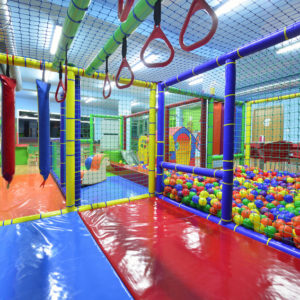Reap the Benefits of an Indoor Playground
 The American Heart Association suggests that kids over the age of two get at least one hour of moderate physical activity every day. Unfortunately, most children don’t meet that standard. Indeed, under a third of children hit the Sports and Fitness Industry Association’s definition of “active to a healthy level,” which is 25 minutes of high-calorie-burning physical activity three times a week. It’s easier in nicer weather, certainly, but what is one to do when it’s cold outside or there are four feet of snow on the ground? An indoor playground can be hugely beneficial to children’s activity levels in places where they have snow or cold temperatures for much of the year. An indoor playground can encourage children who wouldn’t ordinarily get that exercise to go and play and move around.
The American Heart Association suggests that kids over the age of two get at least one hour of moderate physical activity every day. Unfortunately, most children don’t meet that standard. Indeed, under a third of children hit the Sports and Fitness Industry Association’s definition of “active to a healthy level,” which is 25 minutes of high-calorie-burning physical activity three times a week. It’s easier in nicer weather, certainly, but what is one to do when it’s cold outside or there are four feet of snow on the ground? An indoor playground can be hugely beneficial to children’s activity levels in places where they have snow or cold temperatures for much of the year. An indoor playground can encourage children who wouldn’t ordinarily get that exercise to go and play and move around.
What is an Indoor Playground?
Indoor playgrounds can be anything from a commercial indoor jungle gym to something on a bit of a smaller scale. They’re essentially playgrounds inside, specifically designed for children. Usually, the material is soft and contained, with foam wrapped equipment to protect children as they play.
They can range from slides and climbing structures to being more structured with cafes or an art and craft area. A commercial indoor playground might be more elaborate than one found in a school or a church for example; a daycare or other childcare organization might have more elaborate ones.
There might also be sections for different age groups, depending on the size of the kids’ indoor play structure. Since everyone’s needs and capabilities are a bit different, they might have a designated baby or toddler section, a section for younger children, and a section for older kids to use.
What are the Benefits of an Indoor Playground?
One of the main benefits of an indoor playground is allowing children to have structured play and activity no matter what the temperature or weather outside is. If it’s too cold or hot to go outside, they still have another alternative for running around, climbing, and moving, instead of being more sedentary. Increased activity has been shown to give children more focus and be more academically motivated.
It’s also a more contained space than outside, so supervisors and teachers can keep an even closer eye on children and not worry about them going too far. There are also security cameras and first aid kits readily on hand. That with the soft, padded play areas means that kids are also safer.
Just like with an outdoor playground, an indoor playground helps promote creativity, developing social skills, and using their imagination. It can also assist with developing motor skills and problem-solving, which are important at a young age. According to a variety of studies, it’s extremely important for children to regularly perform a wide range of gross motor activities in their first six years of life. If this doesn’t happen, it’s been shown that they might have a lifetime of limited brain power as a result.
How Do I Get One in my Area?
If there’s no type of indoor playground in your area, you might consider asking authorities — whether governmental, your local school, community center, or church — to consider putting one in an area that’s beneficial for the community’s children. You can list the multiple benefits of having one and see if you can get funding — either crowdsourced or through some kind of grant.
There are also smaller structures you might be able to order, purchase, and install yourself (or with the help of others), though they won’t be as complex or wide ranging as a more commercial indoor play structure.
As a parent, if you’re looking for somewhere to bring the kids afterschool or on the weekends or holidays, you can also look around online and see if there are independent indoor playgrounds close by to you, if not directly in your area.
Keep kids active and moving, even in fluctuating weather with an indoor playground! It’ll help keep kids engaged and focused, as well as provide an outlet for their energy.

